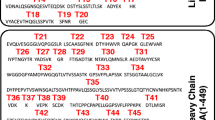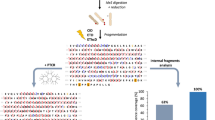Abstract
A liquid chromatography-tandem mass spectrometry method is presented for the quantitative determination of the in vivo deamidation of the biopharmaceutical proteins trastuzumab and pertuzumab at an asparagine in their complementarity determining regions (CDRs). For each analyte, two surrogate peptides are quantified after tryptic digestion of the entire plasma protein content: one from a stable part of the molecule, representing the total concentration, and one containing the deamidation-sensitive asparagine, corresponding to the remaining non-deamidated concentration. Using a plasma volume of 10 µL and a 2-h digestion at pH 7, concentrations between 2 and 1000 µg/mL can be determined for the various protein forms with values for bias and CV below 15% and without unacceptable in vitro deamidation taking place. A considerable difference between the total and non-deamidated concentrations, and thus a substantial degree of deamidation, was observed in plasma for both trastuzumab and pertuzumab. After a 56-day forced deamidation test 40% of trastuzumab and 68% of pertuzumab was deamidated, while trastuzumab and pertuzumab showed up to 47% and 35% of deamidation, respectively, in samples collected from breast cancer patients during treatment with a combination of both drugs. A good correlation between the non-deamidated concentration results and those of a receptor binding assay indicate a loss of receptor binding for both trastuzumab and pertuzumab along with the deamidation in their CDRs. Deamidated trastuzumab also lost its capability to inhibit the growth of breast cancer cells in a cell-based viability assay, suggesting a relation between the degree of deamidation and pharmacological activity.





Similar content being viewed by others
References
Schadt S, Hauri S, Lopes F, Edelmann MR, Staack RF, Villasenor R, Kettenberger H, Roth AB, Schuler F, Richter WF, Funk C. Are biotransformation studies of therapeutic proteins needed? Scientific considerations and technical challenges. Drug Metab Disp. 2019;47:1443–56.
Li Y, Monine M, Huang Y, Swann P, Nestorov I, Lyubarskaya Y. Quantitation and pharmacokinetic modeling of therapeutic antibody quality attributes in human studies. mAbs. 2015;8:1079–87.
Kellie JF, Karlinsey MZ. Review of approaches and examples for monitoring biotransformation in protein and peptide therapeutics by MS. Bioanalysis. 2018;10:1877–90.
Tumey LN, Rago B, Han X. In vivo biotransformations of antibody-drug conjugates. Bioanalysis. 2015;7:1649–64.
Liu YD, Goetze AM, Bass RB, Flynn GC. N-terminal glutamate to pyroglutamate conversion in vivo for human IgG2 antibodies. J Biol Chem. 2011;286:11211–7.
Cai B, Pan H, Flynn GC. C-terminal lysine processing of human immunoglobulin G2 heavy chain in vivo. Biotechnol Bioeng. 2010;108:404–12.
Goetze AM, Liu YD, Arroll T, Chu L, Flynn GC. Rates and impact of human antibody glycation in vivo. Glycobiology. 2012;22:221–34.
Diepold K, Bomans K, Wiedmann M, Zimmerman B, Petzold A, Schlothauer T, Mueller R, Moritz B, Stracke JO, Mølhøj M, Reusch D, Bulau P. Simultaneous assessment of Asp isomerization and Asn deamidation in recombinant antibodies by LC-MS following incubation at elevated temperature. Plos One. 2012;7:e30295.
Haberger M, Bomans K, Diepold K, Hook M, Gassner J, Schlothauer T, Zwick A, Spick C, Kepert JF, Hientz B, Wiedmann M, Beck H, Metzger P, Mølhøj M, Knoblich C, Grauschopf U, Reusch D, Bulau P. Assessment of chemical modifications of sites in the CDRs of recombinant antibodies. mAbs. 2014;6:327–39.
Bults P, Bischoff R, Bakker H, Gietema JA, van de Merbel NC. LC-MS/MS-based monitoring of in vivo protein biotransformation: quantitative determination of trastuzumab and its deamidation products in human plasma. Anal Chem. 2016;88:1871–7.
Mehl JT, Slecka BG, Ciccimaro EF, Kozhich AT, Gilbertson DG, Vuppugalla R, Huang CS, Stevens B, Mo J, Deyanova EG, Wang Y, Huang RYC, Chen G, Olah TV. Quantification of in vivo site-specific Asp isomerization and Asn deamidation of mAbs in animal serum using IP-LC-MS. Bioanalysis. 2016;8:1611–22.
Tran JC, Tran D, Hildebrand A, Andersen N, Huang T, Reif K, Hotzel I, Stefanich EG, Liu Y, Wang J. Automated affinity capture and on-tip digestion to accurately quantitate in vivo deamidation of therapeutic antibodies. Anal Chem. 2016;88:11521–6.
Liu L, Xu K, Li J, Maia M, Mathieu M, Elliot R, Yang J, Nijem I, Kaur S. Optimizing hybrid LC-MS/MS binding conditions is critical: impact of biotransformation on quantification of trastuzumab. Bioanalysis. 2018;10:1819–31.
Yan B, Steen S, Hambly D, Valliere-Douglass J, vanden Bos T, Smallwood S, Yates Z, Arroll T, Han Y, Gadgil H, Latypov RF, Wallace A, Lim A, Kleemann GR, Wang W, Balland A. Succinimide formation at Asn55 in the complementarity determining region of a recombinant monoclonal antibody IgG1 heavy chain. J Pharm Sci. 2009;98:3509–21.
Schmid I, Bonnington L, Gerl M, Bomans K, Thaller AL, Wagner K, Schlothauer T, Falkenstein R, Zimmermann B, Kopitz J, Hasmann M, Bauss F, Haberger M, Reusch D, Bulau P. Assessment of susceptible chemical modification sites of trastuzumab and endogenous human immunoglobulins at physiological conditions. Commun Biol. 2018;1(28):1–10.
Schokker S, Fusetti F, Bonardi F, Molenaar RJ, Mathôt RAA, van Laarhoven HWM. Development and validation of an LC-MS/MS method for simultaneous quantification of co-administered trastuzumab and pertuzumab. mAbs. 2020;12:1795492.
Gui LL, Li L, Dong LH, Xiang SS, Zhai JP, Ge ZQ, Song HF. Method development and validation of LC-MS/MS-based assay for the simultaneous quantitation of trastuzumab and pertuzumab in cynomolgus monkey serum and its application in pharmacokinetic study. Biomed Chromatogr. 2020;34:e4903.
Robinson NE, Robinson AB. Deamidation of human proteins. Proc Natl Acad Sci USA. 2001;98:12409–13.
European Medicines Agency. Guideline on bioanalytical method validation; EMA: London, UK, 2012
Food and Drug Administration. Bioanalytical method validation - Guidance for Industry; U.S. Department of Health and Human Services: Washington, DC, 2018.
Ehrenshaft M, Deterding LJ, Mason RP. Tripping up Trp: modification of protein tryptophan residues by reactive oxygen species, modes of detection, and biological consequences. Free Radic Biol Med. 2015;89:220–8.
Schiffter HA. Pharmaceutical proteins – structure, stability and formulation. In: Moo-Young M, editor. Comprehensive Biotechology, vol. 5. 2nd ed. Elsevier; 2011. p. 521–41.
Harris RJ, Kabakoff B, Macchi FD, Shen FJ, Kwong M, Andya SSJ, Bjork N, Totpal K, Chen AB. Identification of multiple sources of charge heterogeneity in a recombinant antibody. J Chromatogr B. 2001;752:233–45.
Nami B, Maadi H, Wang Z. Mechanisms underlying the action and synergism of trastuzumab and pertuzumab in targeting HER2-positive breast cancer. Cancers. 2018;10:342.
Hudis CA. Trastuzumab – mechanism of action and use in clinical practice. N Engl J Med. 2007;357:39–51.
Acknowledgements
We thank all patients for their participation, the staff of the NKI trial laboratory, in particular dr. T. Korse, who assisted in collecting the samples, and the Dutch Breast Cancer Research Group (BOOG) as the sponsor of the clinical trial.
Author information
Authors and Affiliations
Corresponding author
Ethics declarations
Ethical approval
Samples were collected after ethical approval by the medical ethics committee of the Netherlands Cancer Institute and all patients provided written informed consent prior to study inclusion. All procedures performed in this study involving human participants were in accordance with the ICH Harmonized Tripartite Guideline for Good Clinical Practice and with the 1964 Helsinki Declaration and its later amendments.
Conflict of interest
The authors declare no competing interests.
Additional information
Publisher's note
Springer Nature remains neutral with regard to jurisdictional claims in published maps and institutional affiliations.
Supplementary Information
Below is the link to the electronic supplementary material.
Rights and permissions
About this article
Cite this article
Bults, P., van der Voort, A., Meijer, C. et al. Analytical and pharmacological consequences of the in vivo deamidation of trastuzumab and pertuzumab. Anal Bioanal Chem 414, 1513–1524 (2022). https://doi.org/10.1007/s00216-021-03756-z
Received:
Revised:
Accepted:
Published:
Issue Date:
DOI: https://doi.org/10.1007/s00216-021-03756-z




